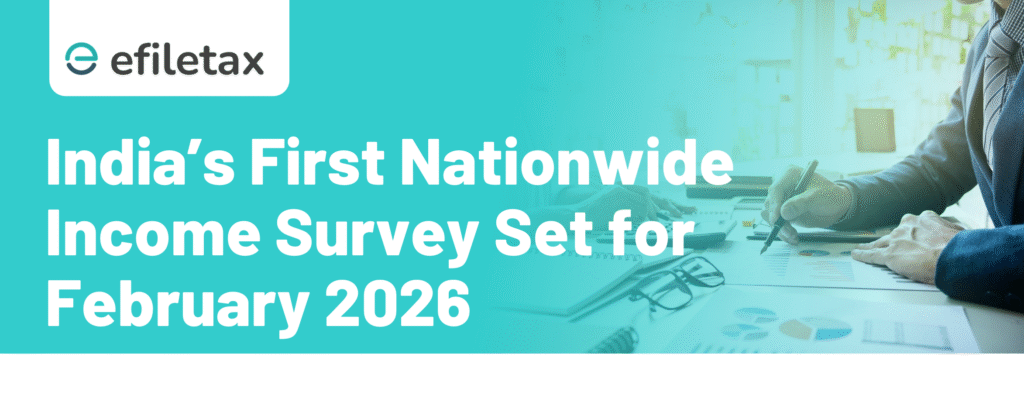
India’s First Household Income Survey 2026 A Big Move for Indian Tax Policy
India is gearing up for its first-ever Household Income Survey 2026, set to launch in February next year. This landmark initiative aims to collect detailed data on how Indian families earn, save, and spend — filling a critical gap in policymaking.
Until now, India lacked an official, nationally representative income dataset. With this new survey, the government intends to align tax policy, social welfare schemes, and economic planning more closely with ground realities.
Let’s simplify what this means for Indian taxpayers and how it could impact future tax reforms.
Why a Household Income Survey Matters
- Current Gap: India has robust data on household consumption (via NSSO), but income estimates rely on indirect indicators.
- Need for Accuracy: Tax policies and subsidies are often based on outdated or estimated figures.
- Global Practice: Most developed countries conduct regular income surveys to inform tax brackets, minimum wages, and benefits.
Expert View:
“Without real income data, we’re flying blind in designing progressive taxation. This survey will be a game-changer,” says Prof. Himanshu, JNU economist and NSSO expert panel member.
What Will the Survey Cover?
The National Sample Survey Office (NSSO), under the Ministry of Statistics and Programme Implementation (MoSPI), will conduct the survey. Key areas of data collection:
- Wages and salaries (private and public sector)
- Self-employment income (business, agriculture)
- Rental, dividend, and interest income
- Government transfers (pensions, subsidies)
- Regional and gender-based income differences
- Shadow income from informal jobs
How This Impacts Indian Taxpayers
Once the survey results are published (likely by FY 2026–27), it could:
- Reshape income tax slabs: Based on actual income distribution
- Improve targeting of subsidies: Through better means testing
- Shift to evidence-based policymaking: For schemes like PM-KISAN or Ayushman Bharat
- Trigger new social security debates: On Universal Basic Income (UBI) or gig worker protections
Legal and Policy Implications
- Finance Commission Impact: The 16th Finance Commission (2026–2031) may use this data to reassess fiscal transfers and tax devolution.
- CBDT Use Case: Better data helps the Central Board of Direct Taxes refine compliance tracking and voluntary disclosure schemes.
- Welfare Law Design: Schemes like NFSA (Food Security Act) and DBT (Direct Benefit Transfer) could be restructured.
Comparison Table: Current vs Future Scenario
| Aspect | Current Status | Post-Survey (Expected) |
|---|---|---|
| Income Tax Bracket Design | Based on assumed income patterns | Based on real household data |
| Subsidy Eligibility | Proxy indicators (e.g., caste) | Direct income-based targeting |
| Urban-Rural Divide | Broad NSSO consumption estimates | Region-specific income insight |
| Informal Sector Inclusion | Poorly represented | Actively mapped in survey |
🔗 Government Sources
- Ministry of Statistics and Programme Implementation
- 16th Finance Commission Terms of Reference
- Income Tax Department – Official Portal
Summary
India will launch its first nationwide Household Income Survey in February 2026 to gather accurate income data. This survey will inform future tax slabs, welfare schemes, and economic reforms — aligning policies with real household earnings for the first time in India’s history.
Frequently Asked Questions (FAQs)
Q1. Will the survey ask for Aadhaar or PAN details?
No, the survey is anonymous. It focuses on statistical trends, not individual tracking.
Q2. Is this linked to tax compliance?
Not directly. The goal is to inform policymaking, not conduct tax audits.
Q3. How is this different from the Economic Census?
The Economic Census covers businesses. This survey focuses on household incomes — including salaried, self-employed, and informal workers.
Q4. Who will be surveyed?
A representative sample of rural and urban households across all Indian states and union territories.
Final Takeaway
India’s first Household Income Survey 2026 could redefine the way we think about income tax, subsidies, and economic planning. As a taxpayer, this is your moment to advocate for data-driven policies that are fair, inclusive, and transparent.